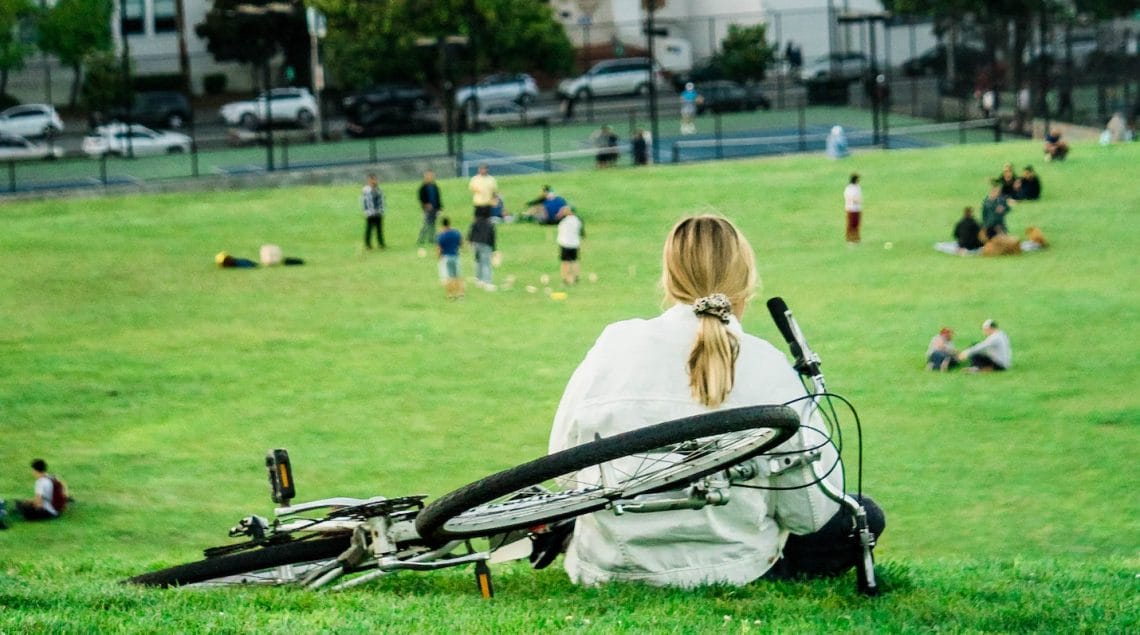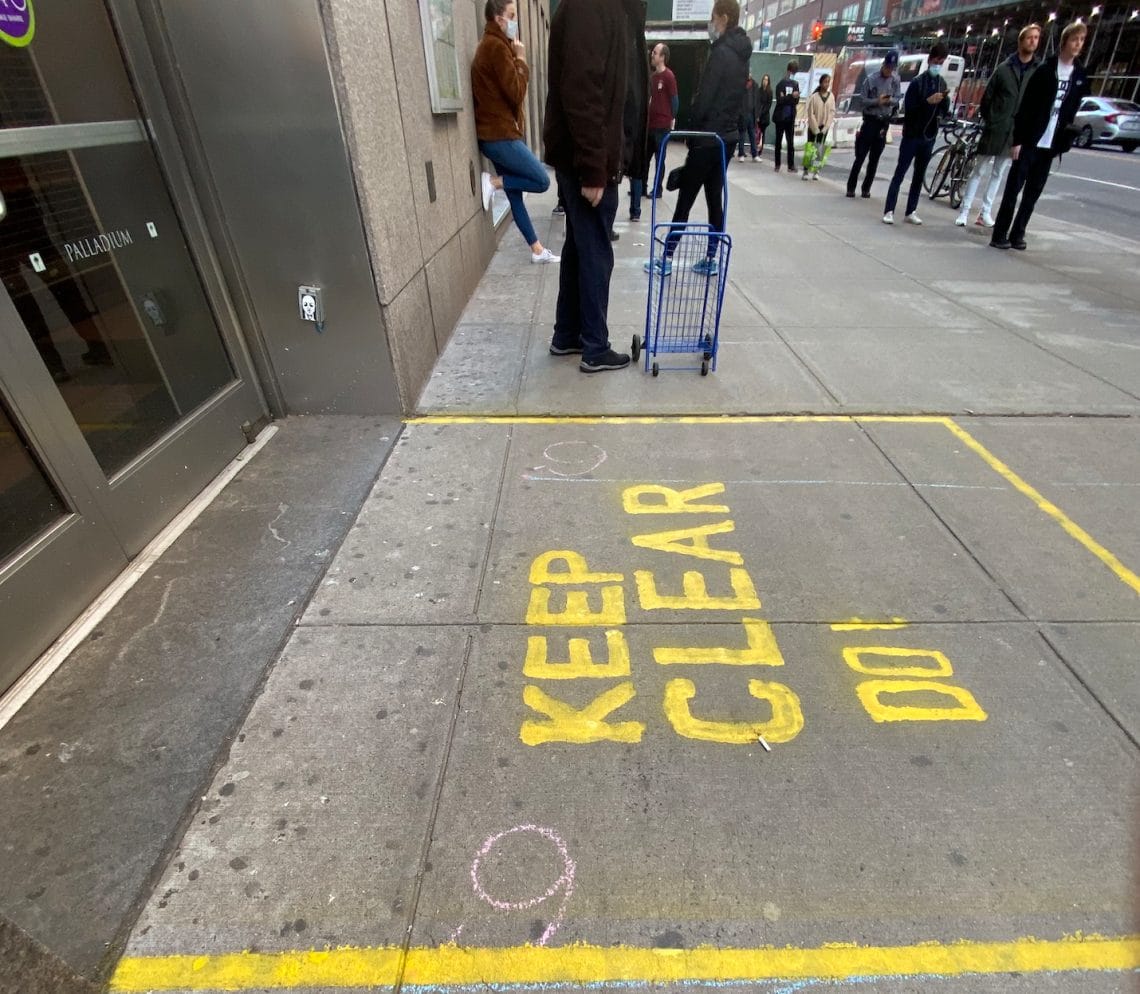This is part of a series of posts about behavioral science and COVID-19. Click here to read about some of the most important behaviors during this pandemic—like seeking medical help, responding to humanitarian crises, and adapting to remote work in a global outbreak.
Social distancing, or physical distancing, as we have started referring to it at ideas42, means that everything about our daily lives changes. Sure, we were never three inches away from people, but now we have to be six feet away. As a result, we’re better off spending as little time as possible in enclosed, crowded spaces like grocery stores.
Our entire physical environment was designed without any such distancing constraints. In some cases, it was even designed for the opposite effect. Grocery stores intentionally put meat and dairy sections in the back of the store, and design the layouts of other staples so that we are forced to walk by other displays and be tempted by other products. Checkout lines are designed for quick flow, but the rest of the store is designed to keep us inside, shopping longer. It’s not limited to commerce–even public parks have incorporated designs for bringing people together, like the typical six-seat picnic tables and common benches that fit two to four people sitting side-by-side placed throughout the space.
In this new world requiring physical distancing, how can we temporarily redesign our public physical environments to make it easier for us to stay safely away from each other? Such design is important because our habits are triggered by cues built into our physical environment. If everything looks and feels the same, we will habitually revert to old behaviors.
We may remember to keep a safe distance sometimes, but we will fail a lot, which has serious consequences in this pandemic. What’s worse is that we won’t realize how much we’re failing because we will be acting unconsciously. If we can design quick, temporary solutions to alter these physical cues, we can trigger better, more effective physical distancing behavior, and in turn help #FlattenTheCurve.
While, of course, the default remains that we should all be staying indoors at home, below we share just a handful of ideas for the public spaces we are likely to emerge for during this period of physical distancing – grocery stores, pharmacies, parks, and the streets that get us to and from.
Grocery Stores & Pharmacies: Tips for Streamlining the Process of Buying Essentials Safely
There are two main things for stores to consider when redesigning their spaces–making it easy for people to remember to effectively practice physical distancing while they’re in the store shopping, and instead of maximizing the time people spend in the store, minimize it.
Before shoppers arrive
- Using email lists, a store website, or store window displays, encourage shoppers to minimize browsing while in the store by offering or directing people to apps that use pre-populated shopping lists or checklists, sorted by common aisle distinctions, like produce, meat, dairy, pastas, baking, beans and canned goods, cereals, cleaning supplies, etc.
- Create visual markers on the ground outside the entrance to encourage distancing while waiting to enter as stores endeavor to control the number of people inside at any given time.
Layout of store and goods
- We know people are crowding around popular pantry items and essentials like bread, dried pastas and canned goods, and cleaning supplies. Rather than creating opportunities for crowding, stores should create three to four separate additional displays of these items around the store near the entrance and checkouts to disperse the crowd, and hopefully reduce the time people spend in the store overall.
- Place frequently purchased goods close to the entrance and checkout lines to further reduce time spent in the store shopping. My local pharmacy, a Walgreens store, has already done this with cleaning supplies.
- Take this a step further by offering pre-packaged bundles of common products so people can grab and go in and out of the store even more quickly.
- Make all aisles one-way with clear waymarks on the ground noting the flow of traffic, and use street traffic signs (do not enter, yield, one-way) to facilitate, as they’re already familiar to people in other contexts
Guidance and reminders throughout store space and at checkout for shoppers
- Tape simple guides on the floor throughout the aisles and around checkout lines to help people space by at least six feet throughout their time in the store.
- If possible, use the store’s audio system to broadcast reminders to stay six feet apart at all times
- By the cash registers, create physical cues on the floor and at the register itself for customers to wait six feet from the checkout until it’s their turn.
- Remove all plastic dividers for placing between orders on the conveyor belt
- Place or paint a picture of feet near where customers can load items while the cashier is ringing up to prompt them to stand there while the transaction occurs, creating enough space between the customer and the checkout clerk.
Increasing options and locations of essentials throughout communities to reduce density in-store
- Stores can offer pickup/delivery services where customers choose a pickup location closer to their home, which removes the need for them to enter the physical store at all. This also offers the advantage of placing pickup spots in less densely populated locations, and is cheaper than home delivery for smaller grocery companies or pharmacy businesses.
- Government officials can encourage independent vendors selling staples around the city by streamlining permitting processes and making access to wholesale supply easier. This also has the added benefit of employing those who may have lost their jobs while also spreading out access to food and cleaning supplies.
Public Sidewalks: Helping People Keep a Safe Distance to and from Essential Services
- This is a time to double down on existing efforts to reduce distractions while in public. Texting or talking on the phone and walking should be kept to an absolute minimum, as we are more likely to stop paying attention and revert to old distance norms, accidentally walking too close to someone.
- Cities and municipalities, particularly in high foot-traffic areas, can temporarily make sidewalks one-way. It would remove one of the complications of effective physical distancing while walking–two way traffic meeting while trying to keep six feet of distance between you and the person in front of you. This could be achieved with posted signs at crosswalks to walk North on the East side of a street and South on the West side, as well as wayfinding arrows painted on the ground in high traffic areas in the direction foot traffic should flow.
Public Parks: Tools for Discouraging Gathering in Public Spaces While Allowing People to Get Fresh Air and Exercise
- Mark walking lanes on paths, like in a swimming pool, especially ones that people use for running.
- Tape spacing guides on benches to make sure resting and sitting is physically distant as well.
- Post clear reminders throughout to not congregate in areas where people would tend to do so, like lawns or near picnic areas. To reduce the burden of generating creative ideas for executing this on overburdened public servants, municipalities can recruit local artists to create installations in the parks that are both attractive to look at (to grab attention) and cues for effective physical distancing.
- Place a physical barrier (plastic tape, tarps etc.) over any publicly accessible grills or similar amenities that encourage gathering, along with signs.
Perhaps these ideas will reach store managers and government officials who could implement them–or, if you’re an official, please reach out to us. We also encourage you to share more ideas with us on Twitter, @ideas42, or email us info@ideas42.org.
If you have seen stores and cities already implementing good ideas, please share photos and we’ll post them on our social media channels.
Stay tuned to this blog for more tips from the behavioral side of COVID-19.




